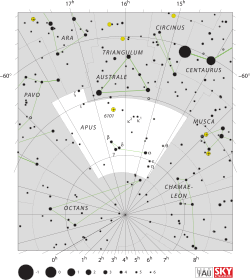Zeta Apodis

| |
| Observation data Epoch J2000 Equinox J2000 | |
|---|---|
| Constellation | Apus |
| Right ascension | 17h 21m 59.47633s[1] |
| Declination | −67° 46′ 14.4072″[1] |
| Apparent magnitude (V) | +4.78[2] |
| Characteristics | |
| Spectral type | K2 III[3] |
| U−B color index | +1.27[2] |
| B−V color index | +1.21[2] |
| Astrometry | |
| Radial velocity (Rv) | +12.6[4] km/s |
| Proper motion (μ) | RA: –37.85[1] mas/yr Dec.: –7.91[1] mas/yr |
| Parallax (π) | 10.97 ± 0.29[1] mas |
| Distance | 297 ± 8 ly (91 ± 2 pc) |
| Details | |
| Radius | 20[5] R☉ |
| Temperature | 4,388[6] K |
| Other designations | |
Zeta Apodis (ζ Aps, ζ Apodis) is the Bayer designation for a star in the southern constellation of Apus. It has an apparent visual magnitude of +4.78,[2] which is bright enough to allow it to be seen with the naked eye. The distance to this star is known from parallax measurements to be around 297 light-years (91 parsecs).[1]
The spectrum of Zeta Apodis matches a stellar classification of K2 III,[3] with the luminosity class of III indicating it is an evolved giant star. The measured angular diameter of this star, after correction for limb darkening, is 2.06 ± 0.02 mas.[8] At the estimated distance of Eta Draconis,[1] this yields a physical size of about 11 times the radius of the Sun.[5] The outer atmosphere has an effective temperature of 4,388 K,[6] which gives it the orange-hued glow of a K-type star.[9]
Naming
In Chinese caused by adaptation of the European southern hemisphere constellations into the Chinese system, 異雀 (Yì Què), meaning Exotic Bird, refers to an asterism consisting of ζ Apodis, ι Apodis, β Apodis, γ Apodis, δ Octantis, δ1 Apodis, η Apodis, α Apodis and ε Apodis. Consequently, ζ Apodis itself is known as 異雀一 (Yì Què yī, English: the First Star of Exotic Bird.)[10]
References
- ↑ 1.0 1.1 1.2 1.3 1.4 1.5 1.6 van Leeuwen, F. (November 2007), "Validation of the new Hipparcos reduction", Astronomy and Astrophysics 474 (2): 653–664, arXiv:0708.1752, Bibcode:2007A&A...474..653V, doi:10.1051/0004-6361:20078357.
- ↑ 2.0 2.1 2.2 2.3 Johnson, H. L. et al. (1966), "UBVRIJKL photometry of the bright stars", Communications of the Lunar and Planetary Laboratory 4 (99), Bibcode:1966CoLPL...4...99J.
- ↑ 3.0 3.1 Houk, Nancy; Cowley, A. P. (1978), Michigan catalogue of two-dimensional spectral types for the HD stars 1, Ann Arbor: Dept. of Astronomy, University of Michigan, Bibcode:1975mcts.book.....H.
- ↑ Wilson, R. E. (1953), General Catalogue of Stellar Radial Velocities, Carnegie Institute of Washington D.C., Bibcode:1953GCRV..C......0W.
- ↑ 5.0 5.1 Lang, Kenneth R. (2006), Astrophysical formulae, Astronomy and astrophysics library 1 (3rd ed.), Birkhäuser, ISBN 3-540-29692-1.. The radius (R*) is given by:
- ↑ 6.0 6.1 di Benedetto, G. P. (November 1998), "Towards a fundamental calibration of stellar parameters of A, F, G, K dwarfs and giants", Astronomy and Astrophysics 339: 858–871, Bibcode:1998A&A...339..858D.
- ↑ "zet Aps -- Star", SIMBAD Astronomical Object Database (Centre de Données astronomiques de Strasbourg), retrieved 2012-02-04
- ↑ Richichi, A.; Percheron, I.; Khristoforova, M. (February 2005), "CHARM2: An updated Catalog of High Angular Resolution Measurements", Astronomy and Astrophysics 431: 773–777, Bibcode:2005A&A...431..773R, doi:10.1051/0004-6361:20042039.
- ↑ "The Colour of Stars", Australia Telescope, Outreach and Education (Commonwealth Scientific and Industrial Research Organisation), December 21, 2004, retrieved 2012-01-16.
- ↑ (Chinese) AEEA (Activities of Exhibition and Education in Astronomy) 天文教育資訊網 2006 年 7 月 29 日
External links
| ||||||||||||||||||||||||||||||||||||||||||||||
